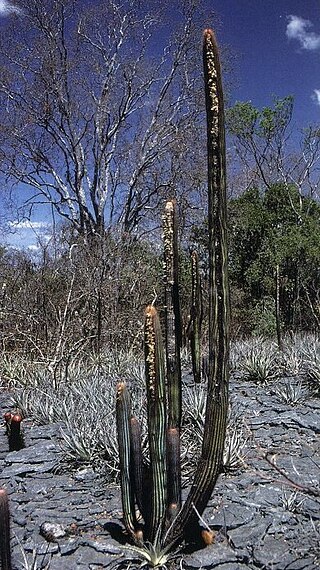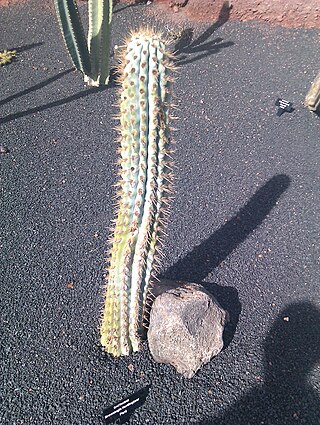
Espostoopsis is a monotypic genus of cactus containing the single species Espostoopsis dybowskii. The generic name is formed from Greek opsis meaning "view", referring to its resemblance to the genus Espostoa, with which it is often confused. The plant is only known from northern Bahia, Brazil.

Quiabentia verticillata is a species of cactus found from Bolivia to Argentina

Micranthocereus dolichospermaticus is a species of plant in the family Cactaceae. It is endemic to Brazil, where it is confined to the states of Bahia and Minas Gerais. Its natural habitat is rocky areas. It is threatened by habitat loss.

Micranthocereus streckeri is a species of plant in the family Cactaceae. It is endemic to Brazil. Its natural habitats are subtropical or tropical moist shrubland and rocky areas. It is threatened by habitat loss.

Micranthocereus violaciflorus is a species of plant in the family Cactaceae. It is endemic to Brazil.

Thelocactus hastifer is a species of plant in the family Cactaceae. It is endemic to Mexico. Its natural habitat is hot deserts.

Cipocereus bradei is a species of cactus. It is endemic to the state of Minas Gerais in Brazil. It is threatened by habitat loss.

Cleistocactus tominensis is a species of columnar cactus in the genus Cleistocactus, endemic to Bolivia, where it is found in forests, on cliffs, and in inter-Andean valleys at altitudes of 900 to 2,200 meters.

Oreocereus trollii, commonly known as the Old Man of the Andes cactus, is a species of cacti native to Argentina and Bolivia. Though listed as Least Concern by the IUCN, the plant is collected extensively, and in some areas is threatened.

Cereus pierre-braunianus is a species of columnar cactus found in NE Goiás in Brazil.

Cereus lanosus or is a species of columnar cactus found in Central, Cordillera, Concepción, and Paraguarí departments of Paraguay. The plant is found growing in rocky hills at elevations of 250 and 300 meters.

Cipocereus minensis is a species of Cipocereus found in Minas Gerais, Brazil.

Browningia hertlingiana is a species of Browningia found in Peru.

Weberbauerocereus winterianus is a species of Weberbauerocereus from Peru.

Loxanthocereus xylorhizus is a species of Loxanthocereus found in Peru.

Cipocereus crassisepalus is a species of cactus endemic to the state of Minas Gerais in Brazil.

Brasilicereus phaeacanthus is a species of Brasilicereus found in Brazil.
Soehrensia quadratiumbonata is a species of Soehrensia found in Bolivia.

Soehrensia smrziana is a species of Soehrensia found in Argentina.

Micranthocereus estevesii is a species of Micranthocereus found in Brazil.
























